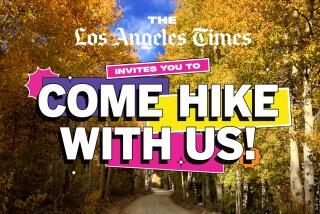Douglas Fir Grow Strong on This Road Less Taken
The south slopes of the Santa Susana Mountains are pretty enough: a brown, brushy backdrop above the ‘burbs of the San Fernando Valley. But this southern exposure offers no clue to what lies on the other side. The north slopes of the Santa Susana Mountains are green, woodsy and unexpectedly rugged. Pretty spectacular, I’d say.
Some of these north slopes are preserved in the Santa Clarita Woodlands, a park extending along the west side of the Golden State Freeway (Interstate 5) just north of its intersection with the Antelope Valley Freeway (California 14). Thriving stands of Douglas fir on the north slopes are one highlight for the hiker. Naturalists think the fir is a relict stand from a time (19,000 years ago or so) when the region’s climate was wetter and cooler than it is today.
Although the Southland has warmed considerably since the first firs took root, today the upper ramparts of the Santa Susana Mountains have temperatures 10 to 15 degrees cooler and receive about twice as much rain as the surrounding flatlands. Light snowfalls are common at elevations above 2,500 feet. The cold, rain and fog drip help the Douglas firs prosper and also help sustain a healthy population of valley oak.
For all the range’s considerable allure, it’s only half-protected. The lower and middle parts of the canyons are in public domain, and the upper parts of the canyons (where most of the Douglas firs reside) and the ridge crest remain in private hands.
During the 1990s, the Santa Monica Mountains Conservancy, with the aid of other governmental agencies and environmental groups, painstakingly assembled a handful of canyons--Pico, Towsley, East and Rice--into the 4,000-acre Santa Clarita Woodlands Park.
East Canyon is a trail that leads to but not through the Douglas fir forests. The trail, a well-graded fire road, continues into the trees and along the crest, but “No Trespassing” signs stop public passage at the current park boundary line.
Before reaching the fir-bidden zone, tree-loving hikers will enjoy other arboreal species, including fine specimens of coast live oak, California bay laurel, big-leaf maple, flowering ash and black walnut.
The Douglas fir, a classic Christmas tree, isn’t the only greenery in East Canyon that lifts the hiker’s spirit. Mistletoe hangs high in the branches of the oaks. Toyon (California holly), its boughs hung with red berries, is abundant along the trail.
A walk among East Canyon’s festive flora accelerated my hiker’s stream of consciousness. First, I thought of Christmas and the arrival of winter, then poet Robert Frost, then his poem “The Road Not Taken.” Upon reaching the “No Trespassing” sign on East Canyon Road, I reacted with anger, impatience and rebellion, and finally channeled all these thoughts and feelings into a positive direction and ended up with a New Year’s resolution:
I resolve to help preserve the road less taken and this mountain range rarely experienced, the Santa Susana Mountains, one of the last best places in Southern California that remain without environmental protection.
Directions to trail head: From the Golden State Freeway (I-5), just north of its intersection with the Antelope Valley Freeway (California 14) in Santa Clarita, exit on Calgrove Boulevard. Turn west as Calgrove becomes Old Road and head south 0.9 mile to parking on the west side of the road. Hiker amenities include a picnic ground landscaped with native plants, water fountain and restroom. The trail begins just down the road from the picnic area.
When rejoining Old Road for the drive home, note that it is a divided highway near the trail head. Proceed with caution.
The hike: From an information board, the road leads past a private corral. Mistletoe crowns the tall oaks en route. After passing an old cattle chute, a reminder of this land’s ranching heritage, the path reaches a signed junction a quarter-mile or so from the start. Branching right is Rice Canyon Trail, which offers a fine little family walk. The path meanders along Rice Creek and crosses it several times. Nearly a mile out, it swings out onto a grassy open slope and up to a viewpoint.
Several steep trails climb farther up the canyon wall and might beckon the careful and experienced hiker.
From the junction, East Canyon Trail begins to climb, first among grand old oaks and maples, then over more open slopes that deliver great views of the fir-topped ridgeline above and the Santa Clarita Valley below.
Not long after reaching the first of the Douglas firs, you encounter a locked gate and a “No Trespassing” sign. Beyond the low gate marking the park boundary, the road ascends into the fir forest and across the crest of the Santa Susanas.
For more of John McKinney’s hiking tips and trails, visit https://www.thetrailmaster.com.
(BEGIN TEXT OF INFOBOX / INFOGRAPHIC)
East Canyon, Rice Canyon Trails
WHERE: Santa Clarita Woodlands.
DISTANCE: From parking area to park boundary via East Canyon Trail is 4.4 miles round trip with 1,000-foot elevation gain; to viewpoint via Rice Canyon Trail is 3 miles round trip with 500-foot gain.
TERRAIN: Bold north slopes of Santa Susanas.
HIGHLIGHTS: Relict stand of Douglas fir plus many more trees, Santa Clarita Valley vistas.
DEGREE OF DIFFICULTY: Moderate by East Canyon, easy by Rice Canyon.
FOR MORE INFORMATION: Santa Monica Mountains Conservancy, tel. (310) 589-3200; Mountains Recreation and Conservation Authority, tel. (310) 589-3230.
More to Read
Sign up for The Wild
We’ll help you find the best places to hike, bike and run, as well as the perfect silent spots for meditation and yoga.
You may occasionally receive promotional content from the Los Angeles Times.






